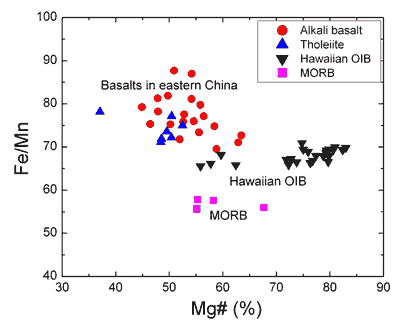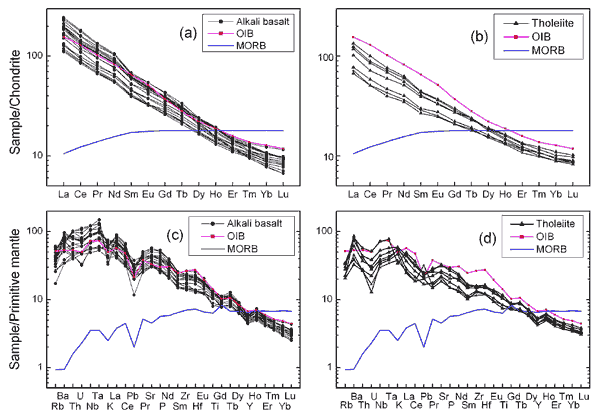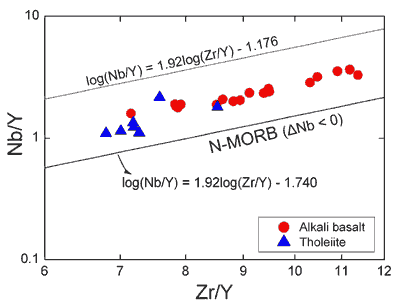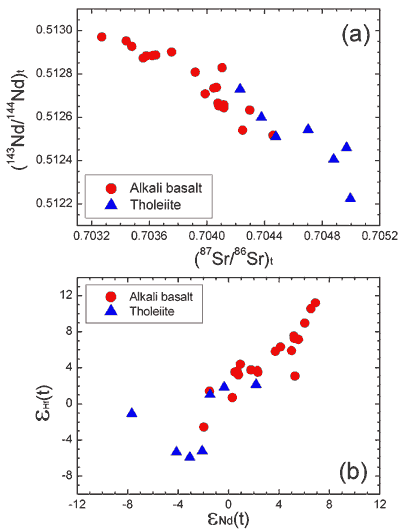Yong-Fei Zheng, Jun-Jun Zhang & Zi-Fu Zhao CAS Key Laboratory of Crust-Mantle Materials and Environments, School of Earth and Space Sciences, University of Science and Technology of China, Hefei 230026, China, yfzheng@ustc.edu.cn ; junjunzhang@uchicago.edu ; zfzhao@ustc.edu.cn This webpage is a synopsis of the paper: Zhang J.-J., Zheng Y.-.F. and Zhao Z.-F. (2009) Geochemical evidence for interaction between oceanic crust and lithospheric mantle in the origin of Cenozoic continental basalts in east-central China, Lithos, 110, 305-326.
Summary We present a novel mechanism for the petrogenesis of continental basalts that explains the OIB-like trace elements and radiogenic isotopes. We derive the alkali basalts from near-solidus melting of silica-deficient pyroxenite, and the tholeiite from silica-excess pyroxenite. We assume the pyroxenites are a transitional lithology in the subcontinental lithospheric mantle that was produced by melt-peridotite interaction between subducted oceanic crust and overlying mantle wedge. We suggest that the pyroxenites acquire their elemental and isotopic features largely from the partial melts of dehydrated oceanic basalts and metasediments. Thus, contributions from the oceanic sediment, altered oceanic basalt and peridotite to the pyroxenites all played key roles in dictating the observed variations in the elemental and isotopic compositions of continental basalts and mantle xenoliths. Introduction Many if not all continental basalts have trace element signatures similar to oceanic island basalt (OIB), and moderately depleted Nd and Sr isotope compositions. Interpretations of their origin are diverse and often controversial. Since basalts in continental settings are less abundant than in oceanic settings, their origin is less clearly defined. However, insight into the origin of continental basalts is of fundamental importance to understanding lithosphere-asthenosphere interactions in relation to chemical geodynamics. In fact, much progress in understanding the crustal contributions to mantle geochemistry of deeper levels has come from indirect methods such as integrating xenolith and basalt studies. Further understanding of the petrological processes that cause mantle heterogeneity requires understanding of the geochemical variations in the upper mantle. Because depleted isotope signatures predominate in Cenozoic continental basalts from eastern China, it has been commonly assumed that they are derived from partial melt from the asthenosphere or lithosphere-asthenosphere interactions (e.g., Flower et al., 1998; Zou et al., 2000; Xu et al., 2005). This assumes that the depleted mantle source is the asthenosphere. These models however do not consider prior enrichments that may have transformed the asthenosphere into juvenile subcontinental lithospheric mantle (SCLM). Furthermore, they cannot explain how an asthenospheric MORB-like trace-element character was transformed into an OIB-like trace-element signature in the continental basalts. On the other hand, these models attributed the enriched isotope signature in some of the basalts to involvement of cratonic SCLM, without distinction between ancient and juvenile SCLM in the magma sources. Geochemistry of continental basalts We studied whole-rock-, major-, and trace elements, Sr-Nd-Hf isotopes, and phenocryst O isotopes for Cenozoic continental basalts in east-central China. These basalts are mainly alkalic. The alkali basalt has lower SiO2 (40.57 to 48.31 wt.%) but higher MgO (5.41 to 12.10 wt.%) than the tholeiite (48.28 to 51.84 wt.% and 3.86 to 6.59 wt.%, respectively). Such differences can result from near-solidus partial melting of different pyroxenites (Yaxley & Green, 1998; Hirschmann et al., 2003; Kogiso et al., 2003; Pertermann & Hirschmann, 2003; Kogiso & Hirschmann, 2006) with the alkali basalt arising from silica-deficient pyroxenite and the tholeiite from silica-excess pyroxenite. The alkalic and tholeiitic basalts have Mg numbers of 44.9 to 63.5 and 37.1 to 52.5, respectively, most of them being lower than the 55.8 to 83.0 for Hawaiian OIB and 55.2 to 67.7 for MORB (Figure 1). They show Fe/Mn ratios of 69.54 to 87.68 and 71.11 to 78.15, respectively, which are generally higher than the 65.6 to 70.9 for Hawaiian OIB and 55.5 to 57.8 for MORB (Figure 1). We interpret the high Fe/Mn ratios for the basalts as indicating partial melting of pyroxenites in the mantle source. This is also consistent with their low Mg numbers and CaO contents.
Figure 1: Plot of Mg number vs. Fe/Mn ratio for Cenozoic basalts in eastern China (Zhang et al., 2009). Mg numbers and Fe/Mn ratios for Hawaiian OIB and MORB are after Humayun et al. (2004) The Chinese basalts have chondrite-normalized REE patterns and primitive mantle-normalized trace-element patterns similar to OIB (Figure 2), but distinctive from MORB. They show LREE enrichment but HREE depletion, subchondritic Nb/Ta ratios, no depletion in Nb and Ta but negative Pb anomalies on a primitive-mantle normalized plot. The trace-element signatures in the Chinese basalts provide at least three constraints on their magma source. First, garnet was present as a residual phase during partial melting, but rutile and phlogopite were dissolved. Second, the source was dehydrated, depleting the water-soluble elements (e.g., Rb and Pb) but not the water-insoluble elements (e.g., Nb and Ta). Third, the direct contribution from partial melting of either the asthenosphere or the cratonic SCLM was insignificant. Although the basalts mostly exhibit negative Rb and Pb anomalies relative to their neighbouring elements, they have less positive Sr anomalies and weaker negative Pb anomalies than OIB. Furthermore, they show a strong positive correlation between Sr and Nb, indicating relatively low extents of dehydration prior to melting. Therefore, the geochemistry of these basalts requires a different source from both MORB and OIB. Figure 2: Plots of REE and trace-element distribution patterns for Cenozoic basalts in eastern China (Zhang et al., 2009). (a) and (b) Chondrite-normalized REE patterns for alkali basalt and tholeiite, respectively, (c) and (d) Primitive-mantle normalized trace-element patterns for alkali basalt and tholeiite, respectively. Click here or on Figure for enlargement. A Nb/Y vs. Zr/Y plot has been used to distinguish OIB from MORB lavas in Iceland and elsewhere (Fitton et al., 1997; Fitton, 2007). It can be also used to test whether the Chinese basalts were derived from a MORB-type mantle source (Figure 3). Fitton et al. (1997) defined ΔNb = 1.74 + log(Nb/Y) - 1.92log(Zr/Y) to characterise the mantle source and minimize the effects of melting degrees, source depletion through melt extraction, and supracrustal processes (e.g., subsolidus alteration). Fitton (2007) found that virtually all Icelandic basalts have ΔNb > 0 whereas all N-MORB has ΔNb < 0. The calculated ΔNb values for the Wan-Su alkalic and tholeiitic basalts are 0.22-0.30 and 0.13-0.38, respectively, suggesting that they cannot be derived from partial melting of the asthenosphere, the presumed mantle source of MORB.
Figure 3: Nb/Y vs. Zr/Y for Cenozoic basalts in eastern China (Zhang et al., 2009). The ΔNb calculations follow the definition of Fitton et al. (1997), with ΔNb < 0 for N-MORB. The isotopically most depleted component of the Chinese basalts occurs in the alkali basalt and has an ISr(t) ratio of 0.703, a εNd(t) value of 6.89 and a εHf(t) value of 11.19 (Figure 4). It corresponds to the youngest Nd and Hf model ages of 293 Ma and 267 Ma, respectively. This component requires the involvement of relatively depleted and thus young SCLM (Late Paleozoic-Early Mesozoic). Only juvenile SCLM is capable of generating basaltic melts with isotopic compositions similar to those derived from the asthenosphere. On the other hand, there are gradual variations in element abundances and isotope compositions from the alkalic to the tholeiitic basalts. This can be caused by variable proportions of mixing between the near-solidus melts from the isotopically depleted silica-deficient pyroxenite and the isotopically enriched silica-pyroxenite. In particular, felsic melt from the dehydrated oceanic metasediment dominates the radiogenic Sr, Nd and Hf isotope contents over the metasomatized peridotite, imparting isotopically enriched signatures to the silica-excess pyroxenite that resembles ancient SCLM.
Figure 4: Plots of whole-rock Sr-Hf-Nd isotopes for Cenozoic basalts from eastern China (Zhang et al., 2009). (a) Initial Sr and Nd isotopic ratios at t = 16 Ma, (b) initial Nd and Hf isotopic ratios at t = 16 Ma. Clinopyroxene phenocrysts from the alkali basalt possess δ18O values of 4.4‰ to 5.7‰, most of which are lower than the normal upper mantle values of 5.6 ± 0.2‰. Olivine phenocrysts have δ18O values of 4.0‰ and 4.5‰, respectively, significantly lower than the normal mantle values of 5.2 ± 0.2‰. This suggests that the alkali basalt acquired the low-δ18O signature from the magma source because mineral δ18O values lower than normal upper mantle values result from water-rock interaction at high temperatures. Equilibrium O isotope fractionation between minerals are small at ambient mantle temperatures so the low-δ18O phenocrysts must have crystallized from low-δ18O magmas. Thus, the basalt source appears to have been depleted in 18O before extensive melting (Eiler, 2001). The source 18O depletion may be caused by partial melting of dehydrated oceanic crust that experienced high-T seawater-rock interaction during its original emplacement as MORB (e.g., Gautason & Muehlenbachs, 1998; Eiler, 2001; Wang et al., 2003). Nevertheless, altered oceanic crust would be dehydrated during subduction, possibly forming metamorphic eclogite before partial melting. The involvement of dehydrated oceanic crust is also consistent with the major- and trace-element characteristics. Partial melting of dehydrated metabasalt (eclogite) typically generates adakitic melts (Defant & Drummond, 1990; Rapp et al., 1991, 2003), which metasomatize peridotite to form silica-deficient pyroxenite (Rapp et al., 1999; Yaxley & Green, 1998; Yaxley, 2000; Sobolev et al., 2005, 2007; Herzberg, 2006). This pyroxenite can be characterized not only by low Mg numbers, high Fe/Mn ratios, no depletion in Nb and Ta but significant depletion in Pb, but also by LREE enrichment and low δ18O values. Although the low Mg numbers and high Fe/Mn ratios could be caused by the involvement of delaminated lower continental crust (Gao et al., 2004, 2008; Lustrino, 2005), the low δ18O values preclude this because the lower continental crust cannot be directly overprinted by seawater-hydrothermal alteration to acquire the low δ18O values. The occurrence of low δ18O for phenocryst minerals in the alkali basalt suggests a very short magma residence time in the mantle because rates of O isotope exchange by diffusion are high between minerals and melt at mantle temperatures (Zheng & Fu, 1998; Zheng et al., 1998). Kinetically, a relatively long duration is capable of homogenizing low δ18O melt with the normal upper mantle. Quantitative modeling suggests that rates of O diffusion in clinopyroxene are close to those in olivine and that under both anhydrous and hydrothermal conditions the timescales required for diffusion re-equilibration across both minerals are 1 ka and 0.01 ka, respectively. This indicates that the maximum timescale for melting, transport and eruption is probably be less than 1 ka. In that case, the low δ18O values inherited from the source may be preserved in clinopyroxene and a few olivine phenocrysts. Therefore, the preservation of low-δ18O phenocrysts in the alkali basalt indicates immediate reaction of low-δ18O adakitic melts with the overlying peridotite, without transportation through the asthenosphere. In contrast, the tholeiite has higher δ18O values for phenocrysts, with a smaller variation than the alkali basalt. This suggests a smaller contribution from the low-δ18O melts to the tholeiite source than to the alkali basalt source. Furthermore, the tholeiite has lower MgO, higher SiO2, higher ISr(t), and lower εNd(t) and εHf(t) than the alkali basalt. In particular, it contains the isotopically most enriched component that has an ISr(t) of 0.705, an εNd(t) of -7.67 and an εHf(t) of -5.92, corresponding to the oldest Nd and Hf model ages of 1.95 Ga and 1.14 Ga, respectively. Thus, it is possible that the tholeiite source contains an ancient SCLM component that is older than 1.1 Ga. However, the cratonic SCLM cannot be responsible for the isotopically enriched component because of the low MgO contents of the tholeiite. The negative εNd(t) and εHf(t) of the tholeiite are also at odds with derivation from partial melting of juvenile slab eclogite. Instead, the tholeiite can be explained by an origin in silica-excess pyroxenite that formed by metasomatization of the felsic melt. The felsic melt was derived from partial melting of dehydrated oceanic metasediment, which is isotopically enriched with high Sr, Nd and Hf elemental contents due to its relative concentration of continent-derived materials (e.g., Sorensen & Grossman, 1993; Plank & Langmuir, 1998; Eisele et al., 2002). As a result, felsic melt can dominate the Sr-Nd-Hf elements and isotopes over the peridotite, imparting isotopically enriched signatures to the silica-pyroxenite. Thus, the tholeiite originates from the same juvenile SCLM source as the alkali basalt, but its isotopically enriched signatures are inherited from the oceanic metasediment rather than the ancient SCLM. Pyroxenites as the source of continental basalts We propose a model of oceanic crust-lithospheric mantle interaction for the petrogenesis of continental basalts, in which only juvenile SCLM would be involved without material from the ancient SCLM and the asthenosphere. We assume low-angle subduction of the Pacific Plate beneath the Eurasian continent during the Early Mesozoic, which may have brought dehydrated oceanic crust below the ancient SCLM in east-central China. The low-angle subduction would have delaminated the lower part of the ancient SCLM into the asthenosphere, and transformed the mantle wedge overlying the subducted oceanic crust to the juvenile SCLM. Dehydrated oceanic basalt would initially become eclogite during subduction and then undergo partial melting to generate the adakitic melt. In contrast, dehydrated metasediment overlying the eclogite slab would partially melt to generate a felsic liquid. Subsequently, the adakitic and felsic melts would ascend rapidly and react with the overlying juvenile SCLM peridotite to form silica-deficient and silica-excess pyroxenites, respectively, during the Late Mesozoic. Thus juvenile SCLM is bracketed by ancient SCLM above and pyroxenites below. Finally, partial melting of the pyroxenites was triggered in far-backarc-extension settings in response to Cenozoic subduction of the Pacific Plate beneath the eastern Eurasian continent, generating the alkalic to tholeiitic basalts. Both adakitic and felsic melts derived from dehydrated oceanic crust are hypothesized to serve as metasomatizing agents for the formation of silica-deficient and silica-excess pyroxenites, respectively. This deep melt-peridotite reaction results from interaction between the oceanic crust and the juvenile SCLM. An assumption behind this hypothesis is that the isotopically enriched component in the pyroxenites originates in the dehydrated metasediment overlying the dehydrated metabasalt (eclogite). Thus juvenile SCLM would be underlain by pyroxenites. As a result, continental basalts were derived from the products of deep melt-peridotite reaction that is petrogenetically coupled with thinning of the ancient SCLM and asthenosphere-lithosphere interactions. Implications for the origin of oceanic basalts Cenozoic continental basalts in eastern China are characterized by OIB-like trace-element patterns with no depletion in Nb and Ta but with negative Pb anomalies on primitive mantle normalized diagrams. They have high Fe/Mn ratios, subchondritic Nb/Ta ratios, and reletively depleted Sr-Nd-Hf isotope compositions. We propose the model of oceanic crust-lithospheric mantle interaction for their petrogenesis where they were principally derived from near-solidus partial melting of pyroxenites in the juvenile SCLM. Partial melting of dehydrated oceanic metabasalts and metasediments is hypothesized to generate adakitic and felsic melts, respectively, metasomatizing the overlying juvenile SCLM peridotite to form isotopically depleted silica-deficient to enriched silica-excess pyroxenites. The near-solidus melting of the pyroxenites in different settings would generate continental basalts bearing all the observed variations of elements and isotopes that were ascribed to mantle heterogeneity. We hypothesize a transition lithology of pyroxenites in the upper mantle, generated by melt-peridotite interaction during or subsequent to slab subduction. This hypothesis can be applied not only to the origin of continental mafic rocks that display the isotopic signatures of either depletion or enrichment, but also to the origin of oceanic basalts. In particular, OIBs can be derived from partial melting of pyroxenites together with mantle peridotite in the upper mantle, without the involvement of mantle plumes. Because their trace element and radiogenic isotope compositions were dominated by the mafic to felsic melts metasomatizing the peridotite, the pyroxenites would have all the observed variations of elements and isotopes previously attributed to mantle heterogeneity. Further studies are needed to characterize the origin of pyroxenites with respect to the time and nature of the melt-peridotite interaction in the upper mantle. References
last updated
15th May, 2009 |
 |
Roadmap | The review process | Home |
| East-central China |
|
| :: HOME :: MECHANISMS :: LOCALITIES :: GENERIC :: |



